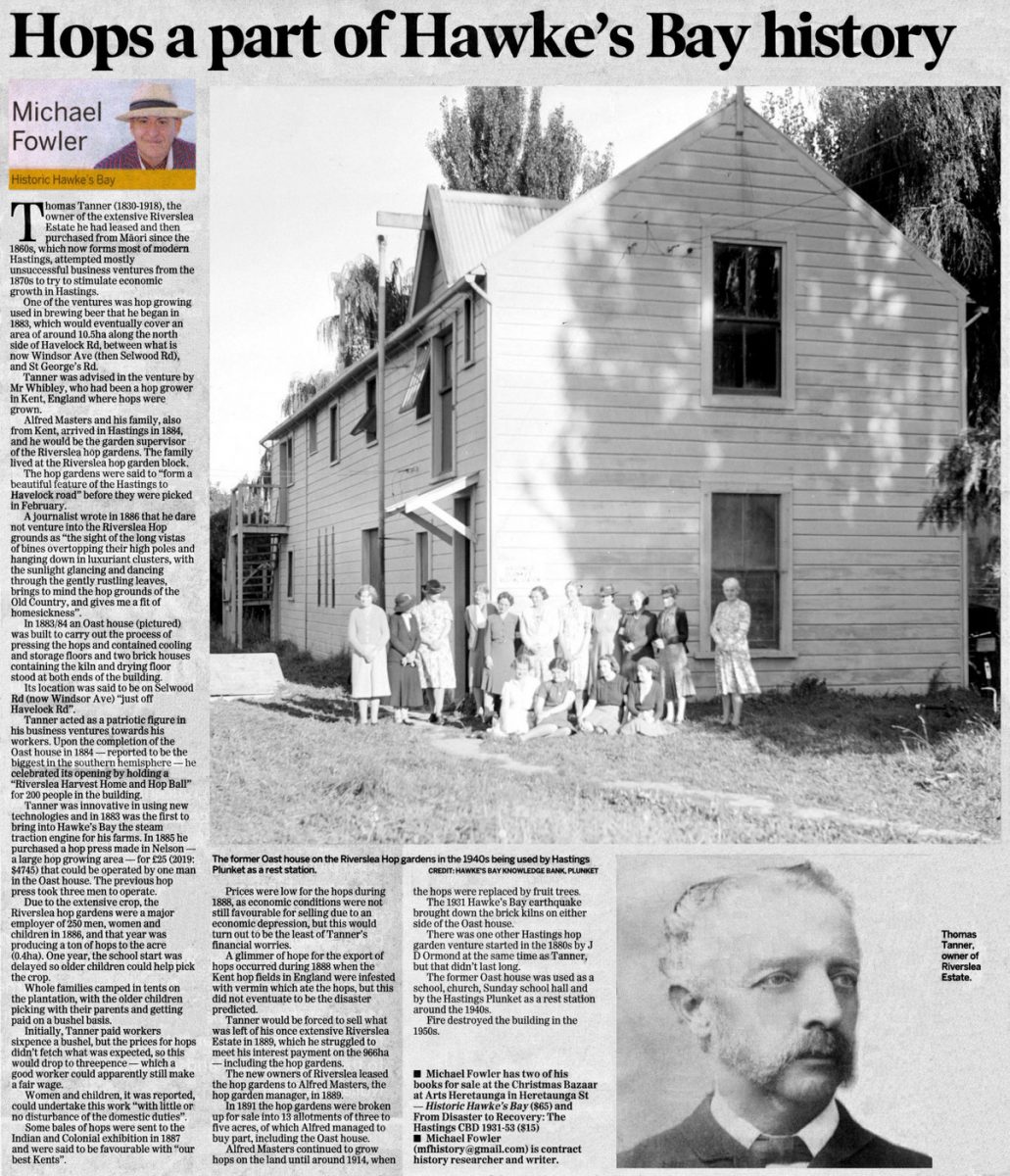Hops a part of Hawke’s Bay history
Michael Fowler
Historic Hawke’s Bay
Thomas Tanner (1830-1918), the owner of the extensive Riverslea Estate he had leased and then purchased from Maori since the 1860s, which now forms most of modern Hastings, attempted mostly unsuccessful business ventures from the 1870s to try to stimulate economic growth in Hastings.
One of the ventures was hop growing used in brewing beer that he began in 1883, which would eventually cover an area of around 10.5ha along the north side of Havelock Rd, between what is now Windsor Ave (then Selwood Rd), and St George’s Rd.
Tanner was advised in the venture by Mr Whibley, who had been a hop grower in Kent, England where hops were grown.
Alfred Masters and his family, also from Kent, arrived in Hastings in 1884, and he would be the garden supervisor of the Riverslea hop gardens. The family lived at the Riverslea hop garden block.
The hop gardens were said to “form a beautiful feature of the Hastings to Havelock road” before they were picked in February.
A journalist wrote in 1886 that he dare not venture into the Riverslea Hop grounds as “the sight of the long vistas of bines overtopping their high poles and hanging down in luxuriant clusters, with the sunlight glancing and dancing through the gently rustling leaves, brings to mind the hop grounds of the Old Country, and gives me a fit of homesickness”.
In 1883/84 an Oast house (pictured) was built to carry out the process of pressing the hops and contained cooling and storage floors and two brick houses containing the kiln and drying floor stood at both ends of the building.
Its location was said to be on Selwood Rd (now Windsor Ave) “just off Havelock Rd”.
Tanner acted as a patriotic figure in his business ventures towards his workers. Upon the completion of the Oast house in 1884 – reported to be the biggest in the southern hemisphere – he celebrated its opening by holding a “Riverslea Harvest Home and Hop Ball” for 200 people in the building.
Tanner was innovative in using new technologies and in 1883 was the first to bring into Hawke’s Bay the steam traction engine for his farms. In 1885 he purchased a hop press made in Nelson – a large hop growing area – for £25 (2019: $4745) that could be operated by one man in the Oast house. The previous hop press took three men to operate.
Due to the extensive crop, the Riverslea hop gardens were a major employer of 250 men, women and children in 1886 and that year was producing a ton of hops to the acre (0.4ha). One year, the school start was delayed so the older children could help pick the crop.
Whole families camped in tents on the plantation, with the older children picking with their parents and getting paid on a bushel basis.
Initially, Tanner paid workers sixpence a bushel, but the prices for hops didn’t fetch what was expected, so this would drop to threepence – which a good worker could apparently still make a fair wage.
Women and children, it was reported, could undertake this work “with little or no disturbance of the domestic duties”.
Some bales of hops were sent to the Indian and Colonial exhibition in 1887 and were said to be favourable with “our best Kents”.
Prices were low for the hops during 1888, as economic conditions were not still favourable for selling due to an economic depression, but this would turn out to be the least of Tanner’s financial worries.
A glimmer of hope for the export of hops occurred during 1888 when the Kent hop fields in England were infested with vermin which ate the hops, but this did not eventuate to be the disaster predicted.
Tanner would be forced to sell what was left of his once extensive Riverslea Estate in 1889, which he struggled to meet his interest payment on the 966ha – including the hop gardens.
The new owners of Riverslea leased the hop gardens to Alfred Masters, the hop garden manager, in 1889.
In 1891 the hop gardens were broken up for sale to 13 allotments of three to five acres, of which Alfred managed to buy part, including the Oast house.
Alfred Masters continued to grow hops on the land until around 1914, when the hops were replaced by fruit trees.
The 1931 Hawke’s Bay earthquake brought down the brick kilns on either side of the Oast house.
There was one other Hastings hop garden venture started in the 1880s by J D Ormond at the same time as Tanner, but that didn’t last long.
The former Oast house was used as a school, church, Sunday school hall and by the Hastings Plunket as a rest station around the 1940s.
Fire destroyed the building in the 1950s.
Michael Fowler has two of his books for sale at the Christmas Bazaar at Arts Heretaunga in Heretaunga St – Historic Hawke’s Bay ($65) and From Disaster to Recovery: The Hastings CBD 1931-53 ($15)
Michael Fowler ([email protected]) is contract history researcher and writer.
Photo captions –
The former Oast house on the Riverslea Hop gardens in the 1940s being used by Hastings Plunket as a rest station. CREDIT: HAWKE’S BAY KNOWLEDGE BANK, PLUNKET
Thomas Tanner, owner of Riverslea Estate.












Do you know something about this record?
Please note we cannot verify the accuracy of any information posted by the community.